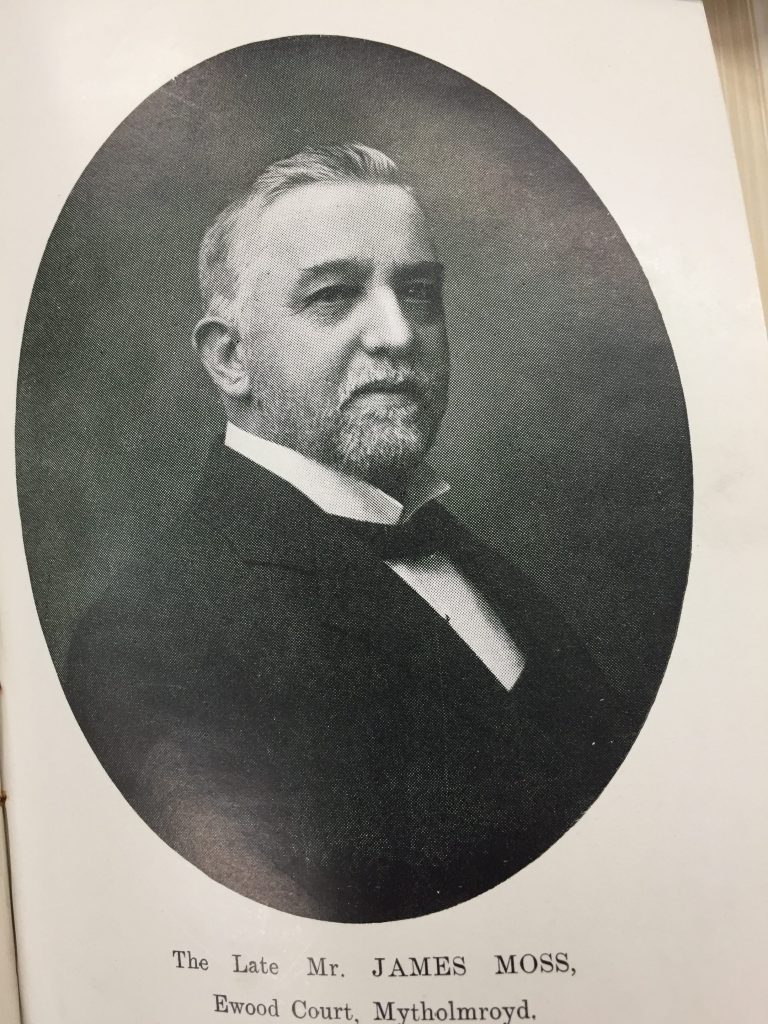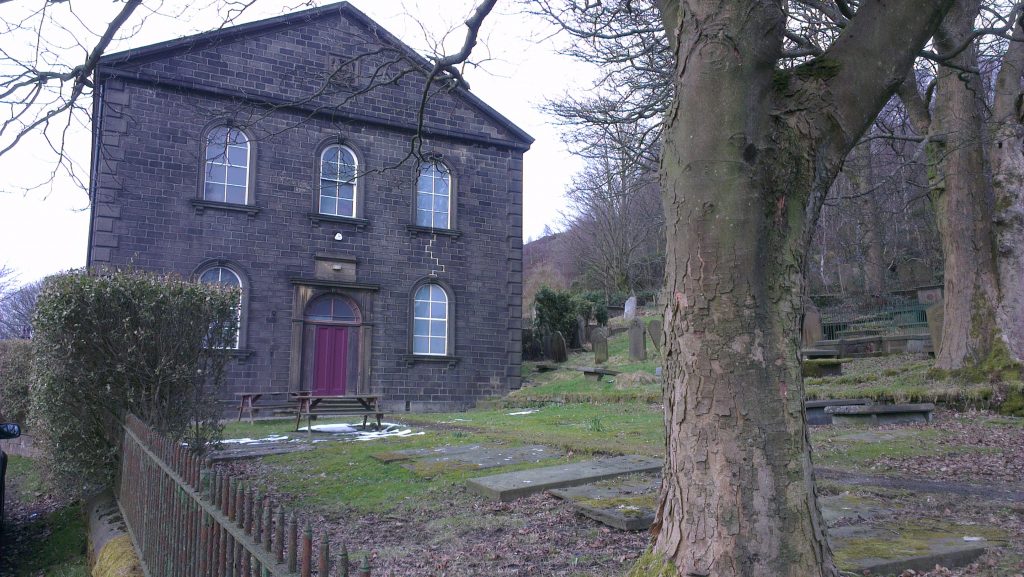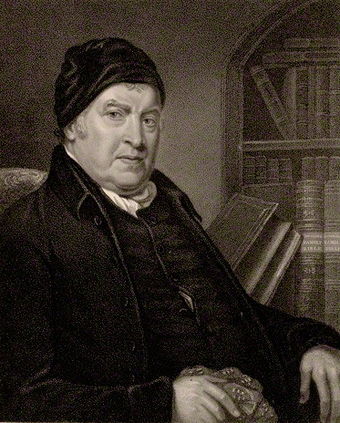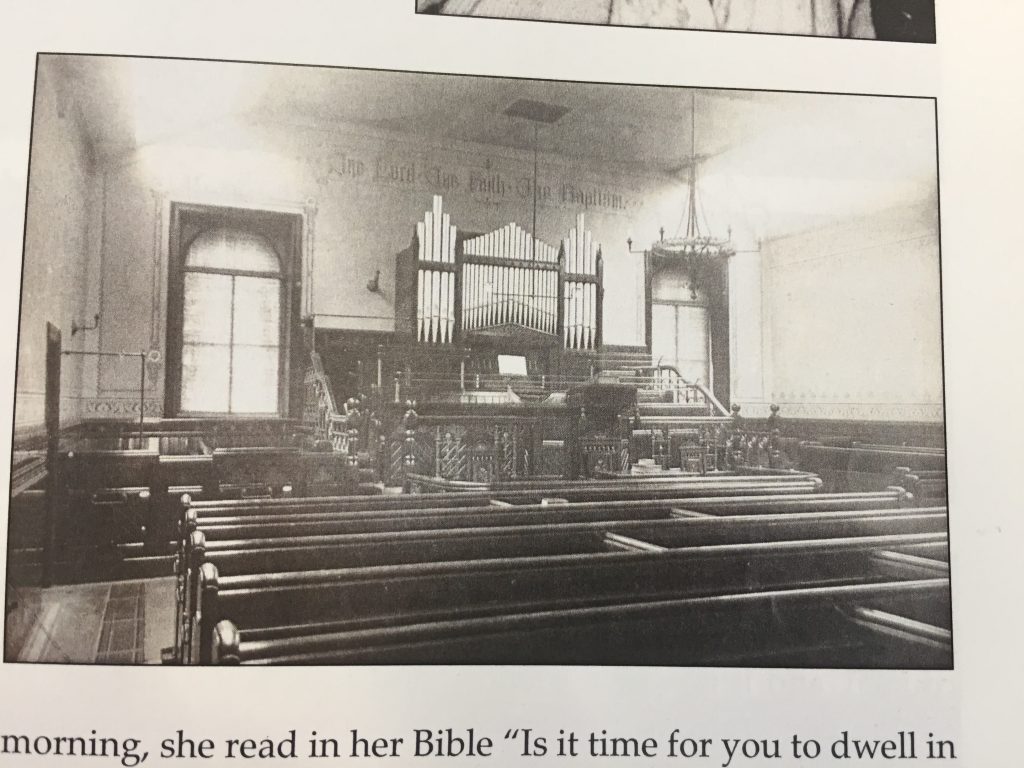2nd great-grandfather of husband of my 3rd cousin 2x removed!
Great-grandfather of Abraham Moss (see post)

James Moss married twice. His first wife, Mary Hague, possibly came from Burnage (unsubstantiated –ancestry.com) after whom Joseph was obviously named gave birth to 11 children, and his second wife, Grace Ashworth had five children. Mary and James were married at Manchester cathedral in 1790 and it was in Manchester that Joseph was born, ( and baptized at Canon Street chapel) though by the birth of their second child a year later the family had moved to Hebden Bridge and were living on King Street. Three of their children died within their first year, and they even named a newborn daughter Esther after their previous daughter Esther had died. Looking at the timing of Mary’s death it’s likely that she died in childbirth since she died almost two years after the birth of her last child at the age of 49. It took James six years to remarry at the age of 46 but even then never more than 2 years elapsed before another child was born until he reached the age of 54 and his wife, Grace Ashworth, was 41. They married at Halifax minster.
James had been a silk weaver in Manchester at the time of their marriage. Middleton, where many of my Denton ancestors lived, was the centre of the silk weaving industry but I’ve not been able to trace where in Manchester James Moss lived.
By January 1806 the family had moved from King street to Machpelah. It has been written: “I don’t think it would be an exaggeration to say that Machpelah was the little acorn from which the mighty oak of the fustian industry in Hebden Bridge grew.” From his obituary in the almanack I discovered more about his life. His first recorded job was as a bookkeeper at Breck Corn Mill, owned by James Bairstow, and he became a riderout, or traveller. In his 20’s he joined his brothers who had commenced business as fustian cutters and manufacturers at Hebble End. James became a member of the Sanitory Authority, 1888-1902, chairman of the council, 1899-1900, Vicechairman of the council 1888-1901. His funeral service was held at Zion Chapel and the casket bearers were his employees. The almanack has a photo of the man taken by Mr Illingworth of Halifax.
He died at Ewood Court, Mytholmroyd from pneumonia, leaving 5 daughters.


He became the senior partner in Messrs Moss Bros and chairman of the English Fustian Manufacturing Company. James’s epitaph at Wainsgate chapel reads:
….also of the said James Moss aged 57 who on the morning of April the 5th departed this life after patient endurance of accumulated suffering, which he knoweth no more.
But freed from sorrow, sin and pain
to golden harps above
Worthy the lamb that once was slain
is now his song of love
and while eternal ages roll
shall glory beam upon the soul.

One of his sons – probably Joseph Hague wrote this elegy:
…“All die,- but not alike on all,
Devolves the fatal strife;
Some bow beneath a sudden call,
And some thrown back on life,
Breathe o’er again their parting breath,
And linger at the gate of death.
The faded cheek, the fallen eye,
Betoken’d quick decay:-
But so my father could not die,
And slowly pin’d away;
The pains he bore from week to week,
Made the flesh quiver on his cheek.”…
One of his descendants has offered to show me the location of the Moss graves at Wainsgate, a remote location high above Hebden Bridge. According to Ken Stott James had a “refined taste for music and conducted in the worship of song. His services in this department were deemed almost indispensable. He was remarkable for the energetic manner in which he conducted the choir, singing heartily “as unto the lord.” According to ‘antiquarian’ “at Machpelah the only houses were those belonging to Mrs Stephen Fawcett and occupied by herself, Mr T. Wade and Miss Moss. The plot of ground adjoining, upon which is now built the house of Mr Abraham Cockroft was Mr Fawcett’s garden. Fawcett’s wife and one grandchild were buried here. That’s when he named the place Machpelah. The bodies were but later reinterred at Wainsgate.
James became a friend of John Fawcett. James would have worn the same type of clothing as Fawcett in his portrait. According to Wikipedia John Fawcett (6 January 1739 – 25 July 1817) was a British-born Baptist theologian, pastor and hymn writer. Orphaned at the age of 12 Fawcett became apprenticed to a tailor and was largely self-educated. He became a Methodists at the age of sixteen under the ministry of G. Whitefield, but three years later united with the Baptist Church at Bradford. Having begun to preach he was, in 1765, ordained Baptist minister at Wainsgate, near Hebden Bridge, Yorks. Ebenezer Chapel, now an art gallery, was built by Dr John Fawcett of the Wainsgate Baptist Church in 1777. It could accommodate 500 to 600 people – for the growing population in the valley at Hebden Bridge. In 1786, work began on a Sunday School. This was one of the first Baptist Sunday Schools in the country. By 1856, the building at Ebenezer was too small and the current church, Hope Chapel, next door to my building was built at a cost of £3,750 and in a prominent site in the developing town. The former building, Ebenezer, was used as the Sunday School and a lecture room. It was at this time that the name Hope was adopted. Each of James Moss’s children was registered at Ebenezer Chapel and in December, 2019 I attended a lecture about the building given by the couple who now live in the rear apartment above the chapel.
In 1772 he was invited to London, to succeed the celebrated Dr. J. Gill, as pastor of Carter’s Lane; the invitation had been formally accepted, the farewell sermon at Wainsgate had been preached and the wagons loaded with his goods for removal, when the love and tears of his attached people prevailed and he decided to remain. In 1777 a new chapel was built for him at Hebden Bridge. This was Hope chapel, which is next door to my building. About the same time he opened a school at Brearley Hall, his place of residence. One of my Moss ancestors lived at Brearley Hall, as did Branwell Bronte! In 1793 he was invited to become President of the Baptist Academy at Bristol, but declined. In 1811 he received from America the degree of D.D., and died in 1817, at the age of 78. Dr. Fawcett was the author of a number of prose works on Practical Religion, several of which attained a large circulation. In 1762, Fawcett joined the Methodists, but three years later, he united with the Baptist Church and became pastor of Wainsgate Baptist Church.

Fawcett served for seven years, despite a small income and a growing family.[ It seemed only practical that he move to a church that paid a larger salary. When he received a call in 1772 to the large and influential Carter’s Lane Baptist Church in London[2] he planned to accept the call. But at the last minute he changed his mind, and remained at Wainsgate where his salary was £25 a year. To commemorate this event,[3] in 1782 he wrote the words to his “Blest Be the Tie that Binds” hymn,[4] his most famous hymn by far.[5]
Fawcett’s grave in the graveyard of Wainsgate Baptist Church
In 1777 a new chapel was built for him at Hebden Bridge, and about the same time he opened a school at Brearley Hall, his place of residence. In 1793 he was invited to become President of the Baptist Academy at Bristol, but declined. In 1811 he received a Doctor of Divinity from America. Fawcett wrote that James was a deacon at the baptist church in Hebden Bridge when Fawcett was the pastor there. All James’s children, apart from Joseph Hague were baptised there.
Grace continued to live at Machpelah, surving her husband by 31 years. She is buried at St James, Hebden Bridge where I have played the organ for occasional services.
Todmorden Advertiser and Hebden Bridge Newsletter – Friday 02 March 1906:
DEATH OF MR. JAMES MOSS, OF HEBDEN BRIDGE. It, is with sincere regret we chronicle the death of Mr. James Moss, of Ewood Court. Mytbolmroyd, and head of the well known firm of Moss Brother., Fustian manufacturers, Hehden Bridge, and Bridge-royd, Eastwood, who died on Monday forenoon last, after short of a week’s illness. He was at his usual place of business on the previous Monday, apparently all right. He was slightly indisposed on the Tuesday, and Dr. Herbert Thomas, of Hebden Bridge, was called in. The illness unfortunately developed into that dangerous complaint, pneumonia, in rather an acute faun. This was the report on Thursday night. Friday morning his relatives and friends were relieved of some anxiety by the report that he had experienced a better night, and was breathing more freely. After that be varied, but the worst does not seem to have been feared until Monday morning, when a bad night had left the patient somewhat exhausted. Dr. Thomas was at Ewood Court early that morning. He recognised the gravity of the case, and suggested that extra medical advice should be called in. But, as it turned out. there was no time left for that. Before anything could he done Mr. Moss hod a bad attack of coughing, and within ⢠few minutes of that, time he departed this life, hie end being somewhat sudden and unexpected. The sad news quickly spread and was received with profound sorrow and regret. It had not been generally known that Mr .Moss was seriously ill, and to those who were ignorant of it the news of his demise came like a shock of consternation but his nearest friends who were acquainted wlth his temperament had not been free from anxiety from the time they learned the nature of complaint. He was taken away in the prime of life, for be was only 55 years of age. He had led an active and energetic business life, and was indeed a business man all through, regular and methodical in hls habits as clockwork, one who made t hobby of his business and really enjoyed it. His place will not be easily filled. He took a deep interest In anything which affected the welfare of the district, and was for more than a dozen years one of the most active members of the Hebden Bridge Urban District Council. A widow and five daughters survive to mourn for the loss of him; but his loss will also be felt in circles far beyond his own family. His business relationships gave him a wide personal acquaintance he was affable. sociable, mid approachable to all. As senior partner in the firm of Messrs: Moss Brothers, fustian manufacturers and dyers and as chairman of the English Fustian Manufacturing Co (a combination of several large business undertakings in the fustian trade), Mr. James Moss occupied an important and influential position In the commercial life of Hebden Bridge and dlstrict At all the branch establishments of the combine flags have floated at half-mast during the week. As a boy Mr. Mose attended his relative’s seminary. familiarly known as “Moss’s school.” at Salem and Slater-bank. His first occupation on leaving school was that ‘of book keeper at Breck Corn Mill, then in the ownership and occupation of Mr. James Bairstow. There he remained for several years. and became the rider-out, or traveller. for the firm. The time came when through declining health Mr. Bairstow wished to retire from the business Mr. James Moss had won the confidence of his employer who entrusted him with responsible posts while still comparativeiy young ; and he was still in the twenties when the Bairstow family made him an offer in conjunction with another employees. to hand over the business to them and find the necessary capital wherewith to work in. For some reason or other Mr. Moss declined the offer, and decided to join his brothers. who had commenced business as fustian cutters and manufacturers at Hebble End. Mr. Hague Moss, their father, seems to have trained the lads in sound business habits. They got on very well together for some time, and not many years had elapsed before it was necessary to take larger premises. Through a local failure they became possessed of the business premises in Brunswick street which still( considerably enlarged,) form the centre of the firm’s various undertakings. One of the brothers had withdrawn previous to that, and the eldest brother, Mortimer, withdrew later, and the business was eventually left in the bands of Messrs James, Fred. and Abraham Mom. From small beginnings it developed Into a great concern, thank. to good business skill and close attention. Some five years ago there sprang into existence the English Fustian Manufacturing Co, a combination of local firms of which that of Messrs Moss Bros was the greatest. Of that combine Mr. James Moss became the chairman. The change made no difference in the regularity and punctuality with which be attended business. Commercial travellers and others who had occasion to call at Brunswick-street were fairly sure that they would find Mr. James Moss at his post. Even the trams knew him for his regularity. He was quite a pattern of punctiliousness in his business affairs. Mr. Mose was first elected a member of the Hebden Bridge sanitary authority, then known as the Local Board. in 1888. He remained a member until 1902. Din ing period he was associated chiefly with the sanitary department, and be certainly took great interest in this and In all the affairs of the Council. He served us chairman of the Council in the years 1899-1900 and as vice chairman in the years 1888-1901.. In this connection he was proudest of hie connection with the Sewerage Committee, with which he was identified on chairman from the time of its formation in 1891 until he was appointed chairman of the Council. And it was during his chairmanship of the council when these works were opened in 1900. Reference war made to his demise at the Hebden Bridge Urban Council meeting on Wednesday night. THE FUNERAL took plain yesterday afternoon. and was of a very imposing character. After a short religious service at the house the cortege left Ewood Court at 12.30, and all along the route from there to Zion Baptist at Hebden Bridge tradesmen drew their shutters and private residents their blinds in silent sympathy with the bereaved. There were mourning coaches following then hearse in the first seven of which, were the chief mourners. Wreaths were sent by Mr. and Mrs. John Crowther, Mr. and .Mrs Young (Heaton chapel), Messrs R. Crabtree & Sons, Sons. Mrs, J. Hutchenson (Bury) Mr. and Mrs. Rose, Miss West, “Rosie” and Messrs. Ashworth Bros. The workpeople connected with Bridge Royd works in a subscription for a floral tribute, but a when it became known that It was the desire of Mrs Moss that there should be no flowers, it was resolved to institute scholarship open to children at Eastwood school, and of the value of 5 pounds.
The bearers were all old employees of the firm of Moss Brothers. The coffin was of polished oak, with solid brass mountings. and the brass plate bore the following inscription JAMES MOSS Born July 11. 1850 ; Died February 28, 1908 At the chapel there was a crowded congregation comprising many of the regular worshippers there, the bulk of the employees of the firm, representatives from business houses and friends of the Hebden bridge UD Council, the English Fustian Manufacturing Society, The Prince Frederick Masonic Lodge, Local War Fund Committee etc. Mr Joseph Smith, who officiates as the regular minister of the church delivered an oration.


Leave a Reply